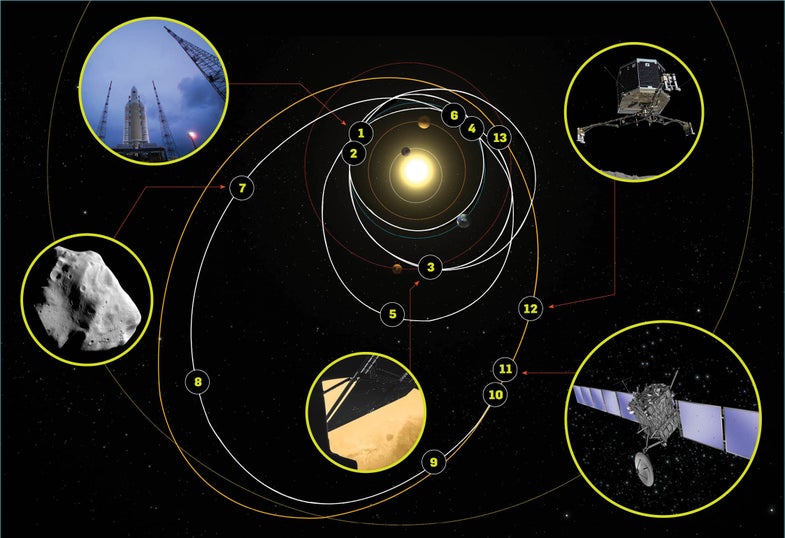A Mission Back In Time
Rosetta is on a journey to unlock the history of the solar system.

After 10 years of circuitous travel, Rosetta has begun to edge toward the icy, black core of comet 67P/Churyumov-Gerasimenko. In August, it will become the first spacecraft to orbit a comet’s nucleus and, shortly after, the first to land a probe on the surface of one. The data it gathers could unlock the history of the solar system, just as the spacecraft’s namesake, the Rosetta Stone, was the key to deciphering Egyptian hieroglyphs. “Because comets are frozen most of the time, they provide a fingerprint of what the conditions were like at the time the planets formed,” says Samuel Gulkis, a scientist at NASA’s Jet Propulsion Laboratory.

March 2, 2004: Rosetta thunders into space aboard an Ariane 5 rocket launched from Europe’s spaceport in Kourou, French Guiana. The main rocket provides 140 tons of thrust, and each booster adds another 700 tons—all told, that adds up to about half the Space Shuttle’s thrust.
March 4, 2005: No rocket is powerful enough to fling a spacecraft 3.7 billion miles, so four planetary flybys provide Rosetta with extra momentum. As Rosetta passes Earth, the planet’s gravity pulls the craft along, increasing its velocity as it sails toward Mars.
February 25, 2007: An instrument on Rosetta‘s probe snaps a picture during the Mars gravity assist.
November 13, 2007: Second Earth gravity assist
September 5, 2008: Rosetta passes within 500 miles of the asteroid Steins in the main asteroid belt between Mars and Jupiter. Its cameras reveal Steins isn’t a solid mass; rather, the interior is a pile of rubble. Material concentrated near its equator as it spun, forming a diamond shape.
November 13, 2009: Third Earth gravity assist
July 10, 2010: Rosetta flies by asteroid Lutetia, a dense, rocky survivor of the primitive solar system, 20 times as large as Steins and roughly 3.6 billion years old. Rosetta‘s cameras image more than 50 percent of its surface, including a 35-mile-wide crater and many smaller pits, grooves, and fractures. Scientists conclude Lutetia is likely a “primordial planetesimal”—an important link between smaller asteroids and planets.
June 8, 2011: As the craft approaches Jupiter, the sunlight reaching Rosetta‘s solar panels dwindles to just a fraction of its strength near Earth. To preserve power (and to weather funding cuts in Europe), Rosetta must go into hibernation for the final third of its trip. The craft briefly fires its thrusters, starts spinning once per minute for better stability, and shuts off all instruments except its computer, radio receivers, and power supply.
January 20, 2014: After three years of hibernation, and though 418 million miles from the sun, Rosetta receives enough solar radiation to power up as programmed. Scientists send commands to switch on its instruments, but radio signals take about 45 minutes each way. “When we turned our instruments on the first time, they were near the Earth, so we got instant feedback,” says James Burch, a scientist at the Southwest Research Institute. “The second time it was an hour and a half, so we were tense.”
May 2014: Comet 67P also “wakes up” and starts to develop a cloud of gases, called a coma, and a tail; Rosetta takes a snapshot. As the icy ball approaches the sun, its frozen gases warm and escape into space, carrying a cloud of dust particles that grows longer and brighter.
August 2014: Thrusters will position Rosetta for arrival. Both the craft and comet are so small that the spacecraft will orbit at walking speed, less than one meter per second. A dozen instruments will study material streaming away from the comet as it warms, including water, carbon monoxide, and ammonia. “In a way, we’re watching the comet undress itself,” Gulkis says. “We can run the clock backwards to go back as far as we’re able and try to understand what the comet was like when it was first formed.” Because the gases will push on Rosetta‘s 105-foot solar panels, engineers will also use the data to plan small course corrections.
November 11, 2014: A probe named Philae has been programmed to self-eject and unfold its three legs. Upon touchdown, a harpoon and ice screws will secure the probe to the surface to prevent it from escaping the comet’s weak gravity. There, Philae will take high-resolution panoramic photos, drill nine inches into the nucleus, and perform on-the-spot analysis of ice and organic material, beaming its findings to Rosetta for radio transmission to Earth. Solar panels will continue to charge its battery as long as they aren’t covered by dust.
December 2015: Rosetta will continue to fly alongside comet 67P as it makes its closest pass of the sun, at a distance of 111 million miles, in August. Although its primary mission ends in December, Rosetta could keep going if it survives the trip—and gets additional funding.
Know Your Space Rocks
Both comets and asteroids orbit the sun, occasionally strike Earth, and are leftover from the formation of the solar system—but they have little else in common.
